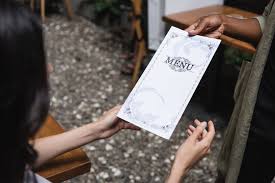A menu is a document that controls and directs an outlet’s operations and is considered the primary selling instrument of a restaurant.
It is a statement of food and beverage items available or provided by food establishments, primarily based on consumer demand and designed to achieve organizational objectives. It serves as the focal point around which components of food service systems are built.
The menu is carefully designed with the clientele in mind. The main advantage of a well-planned menu is that it leads to consumer satisfaction. It also helps motivate employees for responsible and successful service.
A successful menu depends on the right combination of foods, prepared perfectly, to the complete satisfaction of the customer.
What is a Menu?
In a restaurant, a menu is a list of dishes served or available for a diner to select from. The items available for selection are categorized based on the time of day or the event.
Compiling a menu is the most critical aspect of a caterer’s work, regarded as an art acquired only through experience and study. The menu acts as a link between the guest and the establishment, requiring careful planning by professionals such as the executive chef, the food and beverage manager, and the food and beverage controller.
Read Also: Methods of Castration in Sheep and Goat
History of the Menu

The word “menu” dates back to 1718, though the practice of creating such lists is much older. In earlier times, the escrieau (bill of fare) or menu for ceremonial meals was displayed on the wall for kitchen staff to follow the order of dish service.
Menus were once like a large dictionary, with sections covering various dishes, listed in a seemingly random fashion, whether raw, prepared, or cooked. Individual menus emerged in the early 19th century, with courses becoming standardized.
For special occasions, seven or more courses might be served, such as hors d’oeuvres, soup, fish, entrée, sorbet, roast, sweet, and savory.
With menu formalization, artistry and flair began to influence cooking styles, and dishes were named after notable figures, such as Peach Melba, a dessert of poached fresh peach, vanilla ice cream, and raspberry puree, created by Escoffier at the Savoy for opera singer Dame Nellie Melba.
As the 20th century progressed, global migration introduced diverse food and service styles, leading to a rise in ethnic dishes and restaurants. Eating at workplaces, schools, hospitals, and institutions created a demand for healthy, budget-conscious food.
Rapid air transport expanded access to global ingredients, offering menu planners a vast range of choices alongside domestic produce.
Over time, lengthy single-copy menus evolved into smaller, multiple-copy formats, allowing several to be placed on tables. Depending on the establishment and occasion, menus may be plain or artistic in presentation.
Types of Menus
In a restaurant, two primary types of menus are distinguished by their service and pricing methods: à la carte and table d’hôte.
1. À La Carte Menu: An à la carte menu is a multiple-choice menu, with each dish priced separately. Guests select their desired items, and the menu is traditionally presented on a small chalkboard, as the French term à la carte means “according to the board.”
All items, including sauces made with wine, cream, or mustard, are cooked to order. Cooking times vary, so guests should be informed about preparation times. An extensive à la carte menu is impressive but requires significant mise-en-place (preparation).
2. Table d’Hôte Menu: Table d’hôte, meaning “host’s table” in French, refers to a fixed menu offering multi-course meals with limited choices at a set price, also known as prix fixe (fixed price). Typically, it includes three or five courses.
Cutlery is often pre-set for all courses, with the outermost utensils used first, progressing inward as courses are served. Historically, when inns offered limited-choice menus, guests preferred à la carte options for greater flexibility. Fixed menus remain common in forms like buffet menus, conference packages, and special occasions.
In transport catering (air, rail, sea), table d’hôte menus dominate, offering limited or no choices, except for first-class air passengers. Cruise liners may provide elaborate fixed menus with multiple options per course.
3Differences Between À La Carte and Table d’Hôte
| À La Carte | Table d’Hôte |
|---|---|
| Food is semi-prepared and takes time to serve. | Food is fully prepared and can be served immediately. |
| Items are individually served; guests pay for what they order. | Menu is collectively priced; guests pay for the full menu, regardless of consumption. |
| Offers a vast choice with an elaborate menu. | Offers limited or no choice with a smaller menu. |
| Silverware is laid according to dishes ordered. | Silverware for the entire menu is laid in advance. |
Other Types of Menus

- Special Party or Function Menus: Designed for banquets or events, these may be fixed-price or individually priced.
- Ethnic or Specialty Menus: Focus on specific cuisines (e.g., Chinese, Indian, kosher) or food types (e.g., steak, vegetarian).
- Hospital Menus: Typically presented as a menu card for patients to select preferences a day in advance, accommodating dietary and religious needs.
- Menus for People at Work: Vary by employer, offering American, British, or Nigerian dishes, with ethnic and vegetarian options, often including salad bars and healthy choices.
- Menus for Children: Emphasize healthy, balanced diets in schools, with culturally appropriate options and kid-friendly portion sizes.
- Cyclical Menus: Compiled for a set period (e.g., one or three months) for establishments like industrial cafeterias or hospitals. They repeat after the cycle, reducing the need for constant menu planning but require monitoring for customer preferences and seasonal changes.
Advantages of Cyclical Menus
- Save time by eliminating daily or weekly menu compilation, though slight adjustments may be needed.
- Enable efficient cook/freeze operations by producing standardized portions for the entire cycle.
- Improve efficiency in time and labor.
- Reduce stock requirements and aid in planning storage.
Disadvantages of Cyclical Menus
- Risk boring customers in establishments with captive audiences if the cycle is too short.
- Limit the ability to take advantage of daily or weekly supplier deals unless items align with the menu.
Factors to Consider Before Planning a Menu
- Competition: Assess local competitors’ prices and quality; consider offering a unique menu.
- Location: Study the area and target market (e.g., office workers needing quick service).
- Outdoor Catering: Evaluate opportunities for outdoor or take-away services.
- Estimated Cost per Head: Critical for hospitals, schools, or industrial catering, ensuring value for money.
- Food Trends: Balance modern food fashions with traditional dishes, deciding whether to price dishes individually or offer set menus.
- Kitchen Space and Equipment: Avoid overloading equipment like deep fryers or steamers.
- Staff Capability: Ensure staff numbers and skills match menu demands to maintain quality.
- Supply Availability: Consider seasonal foods, storage space, and supplier reliability.
- Food Allergies: Account for dietary restrictions.
- Cost Factor: Essential for profitability, using modern tools to analyze costs daily.
Menu Format
In haute cuisine restaurants, table d’hôte menus are often handwritten to emphasize tradition. In less formal settings, blackboards list daily specials. Menus, whether table d’hôte or à la carte, are typically prepared in-house and duplicated as needed. A separate daily specials menu may also be provided.
Language should be simple, accurate, and appetizing, avoiding repetitive flavors or colors. Numbering items saves time but may reduce guest-staff interaction, so a numbered menu at the register can balance efficiency and engagement.
Read Also: Ruminant Animals: A Comprehensive Guide
Basic Principles of Organizing a Menu

- List cold and warm dishes separately.
- Group appetizers, soups, seafood, and main courses distinctly.
- List lighter dishes before richer ones within each group.
- Highlight salads and low-calorie options, including calorie counts.
- Note organically grown ingredients for discerning customers.
- Describe dishes clearly and simply, without excessive embellishment.
- Align house specialties and seasonal items with the season, using clip-on menus or inserts.
- List desserts on a separate, attractive card, informing guests of its availability.
- Use numbering to streamline orders, but encourage verbal communication to promote sales.
The Order of Courses for a Dinner Menu
While full-course dinners are rare today, the sequence of courses remains important. Modern dinners typically include four or five courses, but caterers should master the full sequence for perfect menu compilation.
1. Three-Course Dinner Menu:
- Hors d’oeuvres or soup
- Main course with vegetables, potatoes, or salad
- Sweet or savory
2. Four-Course Dinner Menu:
- Hors d’oeuvres or soup
- Fish course
- Main course with vegetables, potatoes, or salad
- Sweet or savory
3. Five-Course Dinner Menu:
- Hors d’oeuvres or soup
- Fish course
- Main course with vegetables, potatoes, or salad
- Sweet
- Savory
4. Six-Course Dinner Menu:
- Hors d’oeuvres or soup (potage)
- Fish (poisson)
- Entrée
- Main (relevé or remove) with potatoes and vegetables or salad
- Sweet (entremets)
- Savory (savoureux or bonne bouche)
5. Seven-Course Dinner Menu:
- Hors d’oeuvres or soup
- Potage
- Poisson
- Entrée
- Relevé/remove with potatoes and vegetables
- Roast (rôti) with salad
- Entremets or bonne bouche
6. Eight-Course Dinner Menu:
- Hors d’oeuvres
- Potage
- Poisson
- Entrée
- Relevé/remove with potatoes and vegetables
- Rôti with salad
- Entremets
- Savories or bonne bouche
Examples of Different Menus
Breakfast Menu:
Offered as continental, table d’hôte, à la carte, or buffet. Includes:
- Fruits, juices, stewed fruit, yogurts, cereals (e.g., porridge)
- Eggs (fried, boiled, poached, scrambled, omelets with bacon, tomatoes, mushrooms, or sautéed potatoes)
- Fish (kippers, smoked haddock, kedgeree)
- Hot meats (bacon, sausages, kidneys with tomatoes, mushrooms, or sautéed potatoes)
- Cold meats (ham, bacon, pressed beef with sautéed potatoes)
- Preserves (marmalade, jams, honey)
- Beverages (tea, coffee, chocolate)
- Bread (rolls, croissants, brioche, toast, pancakes, waffles)
A menu is a statement of food and beverage items offered by food establishments, driven by consumer demand and organizational goals. A successful menu hinges on the right combination of foods, perfectly prepared, to satisfy customers. Menus are primarily à la carte (individually priced) or table d’hôte (fixed-price, multi-course).
In haute cuisine, table d’hôte menus may be handwritten for tradition, while less formal venues use blackboards for specials. Menus should use simple, accurate language, avoid repetitive flavors, and employ numbering for efficiency while encouraging guest-staff interaction.
Do you have any questions, suggestions, or contributions? If so, please feel free to use the comment box below to share your thoughts. We also encourage you to kindly share this information with others who might benefit from it. Since we can’t reach everyone at once, we truly appreciate your help in spreading the word. Thank you so much for your support and for sharing!

